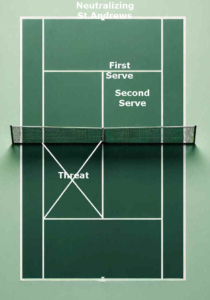Doubles: Neutralizing St Andrews Strategy
Defending against the St. Andrews Cross net strategy in doubles tennis involves strategic positioning and shot selection to counteract the pressure and coverage provided by this formation. Here are some tactics to consider:
For the Receiver.
1. Lobbing: One of the most effective ways to disrupt net players positioned in the St. Andrews Cross is by lobbing the ball over them. Aim for deep lobs to push your opponents back and force them out of their advantageous net position. This can open up the court for subsequent shots or force them into a defensive stance.
2. Passing Shots: Work on precise and low passing shots down the line or cross-court. The key is to hit with accuracy and keep the ball low, making it difficult for the net player to execute an effective volley. Mixing up your passing shots keeps the net players guessing and can create opportunities for winners.
3. Dipping Shots: Use topspin to hit dipping shots that fall quickly after crossing the net. These shots are challenging for net players to handle, especially if they are aiming to volley from a higher position. Dipping shots can force errors or result in weaker volleys that you can exploit.
4. Angle Shots: Exploit angles to pull your opponents out of position. Sharp angle shots, especially when executed with slice or topspin, can stretch the net player beyond their comfort zone, creating gaps in their coverage that you can exploit on subsequent shots.
5. Use the Middle: Hitting firm shots down the middle can create confusion and hesitation between the two net players. This strategy takes advantage of the reduced reaction time available to players in close proximity and can lead to forced errors or missed opportunities for volleys.
6. Attack the Second Serve: A strong service return will limit the net player’s ability to poach effectively and take time away from the service team. A solid well-hit return can neutralize the server’s advantage and put the serving team on the defensive from the outset of the point.
From the Receiver’s Net Person Perspective.
When you’re the receiver’s partner and up against the St. Andrews Cross net strategy, adjusting your positioning and strategy based on the serve can significantly impact your ability to defend and counter-attack. Here’s a tailored approach considering whether you’re facing a first or second serve:
1. For the First Serve:
– Stand closer to the T in the service box. This position allows you to cover the middle more effectively and be ready to counter the threat from the server’s net person, who might be looking to poach or cut off the return.
2. For the Second Serve:
– Move to an Offensive Position: Adjust your stance to mirror the St. Andrews Cross position. This means positioning yourself in a way that allows you to be more aggressive on the second serve return, putting you and your partner on the offensive.
From this position, you’re well-placed to anticipate the serve and the subsequent play, allowing you to take control of the rally early. Whether it’s a strong, deep return that forces the server back or a strategic shot that challenges the net player, your goal is to dictate the pace.
Incorporating these adjustments into your strategy when facing the St. Andrews Cross net formation can help you and your partner neutralize the net threat and transition from defense to offense more effectively.
By varying your position and approach based on the serve, you not only disrupt the serving team’s strategy but also create opportunities for your team to take control of the point.
Remember, the key to successfully countering this formation is flexibility, communication with your partner, and the ability to quickly adapt to the dynamics of the game.


